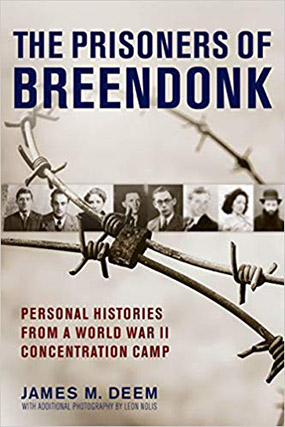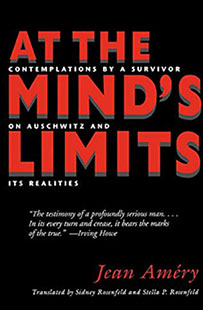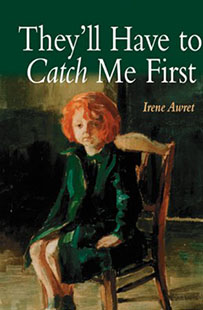Hardcover edition, 2015.Paperback edition, 2020.
|
~~ Suggestions for Visiting Fort Breendonk ~~ ~~ ~~ Related Books by James M Deem: ~~ |
Fort Breendonk was built in the early 1900s to protect Antwerp, Belgium, from possible German invasion. Damaged at the start of World War I, it fell into disrepair . . . until the Nazis took it over after their invasion of Belgium in 1940.
Never designated an official concentration camp by the SS, it was labeled an Auffanglager, a type of camp where prisoners—Jews, communists, resistance fighters, and common criminals—were held until they were either released or transported to other concentration camps. No matter what term the Nazis used, most people familiar with Breendonk during and after the war referred to it as a concentration camp. It was just as brutal and deadly, according to many of its prisoners. One man who survived Breendonk wrote that although the camp “had no gas chambers, no incinerators . . . Breendonk was no less notorious, no less a black hell of the most barbarous terror.” Another claimed that he “would prefer to spend nineteen months at Buchenwald than nineteen days at Breendonk.” A historian describing the concentration camp of Auschwitz I before the nearby extermination camp of Auschwitz-Birkenau was built wrote that the camp “was widely known as a site of imprisonment, extreme brutality, starvation, illness, and high mortality rates, including killings by various forms of torture, shooting, and hanging.” The same description could be applied to Breendonk, only on a smaller scale.
Like most non-Belgians, I had never heard of Breendonk until September 2010, when I visited it while on vacation in Belgium. It took only a few minutes to realize that I not only wanted to know more about the camp, I wanted to write a book about it. I was haunted by the stories and the photographs of the prisoners that hung on exhibit in the dark and dank rooms of the camp.  One image in particular stayed with me: a photograph of a man named Israel Neumann. It was his heartbreaking story that propelled me to learn more about Breendonk and its prisoners.
One image in particular stayed with me: a photograph of a man named Israel Neumann. It was his heartbreaking story that propelled me to learn more about Breendonk and its prisoners.
I made at least a dozen visits to Belgium and Breendonk as I worked in its archives, wandered through its echoing deserted hallways on rainy afternoons, studied the stucco wall in the courtyard, stepped into the torture chamber, and stood in silence on the execution grounds. I also met with relatives of some men who had been imprisoned there. The stories woven through this book are taken from autobiographies, interviews, archival documents, and courtroom testimonies. I did not invent any dialogue; every word that appears in the conversations was quoted from one of these sources. The only imagination I used was when he described what a prisoner might have experienced, and these suppositions were based on the writings of other prisoners. I have included photographs, often undated, of many prisoners as well, so that the reader can see their faces. But photographs were not available for everyone, especially those who died and had no surviving family. This was true of many Jewish prisoners whose families were deported to their deaths.

Plan of Fort Breendonk, surrounded by a moat and entered only across a drawbridge, much like a medieval castle

The entrance to Fort Breendonk today
![]()
Honors and Reviews
2016 Notable Children's Trade Book in the Field of Social Studies (National Council for the Social Studies and the Children's Book Council)
A 2015 selection of the Junior Library Guild
2015 Cybils Awards Nomination, Young Adult Nonfiction
#14 Bestselling Informational Book in Belgium, 2015
2016 Best Children’s Books of the Year (History, Outstanding Merit--Bank Street College of Education)
Best Teen Nonfiction 2015, Chicago Public Library |
 SCHOOL LIBRARY JOURNAL
SCHOOL LIBRARY JOURNAL
(starred review)
"This title sheds light on the Nazi prison camp Breendonk. Never designated as a concentration camp, Breendonk (an old fort intended to defend Antwerp, Belgium, in World War I) was referred to as a “reception” camp. Regardless of its title, Breendonk held about 3,600 prisoners between 1940 and 1945. Jews, communists, common criminals, and freedom fighters all found themselves subject to incarceration. Life in Breendonk was no different than that in any of the better-known camps. It served as a 'feeder' to Mauthausen, Buchenwald, Sachsenhausen, and several other camps. This narrative is told through the lives of various prisoners who lived (and died) there. Liberally illustrated with black-and-white photographs of the camp, its officials, and the prisoners, the book is well written and well organized. Many drawings done by one of the prisoners are also included...."
 JEWISH BOOK COUNCIL
JEWISH BOOK COUNCIL
(starred review)
"An album of Nazi evil, this is a well-illustrated book with photos and drawings and stories of many inmates from the start of their incarceration to its end. One prisoner, after having spent so much time in Breendonk, was relieved to reach Buchenwald. Some prisoners were brave and noble; others were pitiful and suffering, but among them was one man, a Jew named Walter Obler, who as a guard, a Zugführer, developed a reputation for extreme cruelty. He was punished along with the Nazis at the end of the war. This is a plain-spoken, well described and documented narrative with plentiful photographs and maps, including portrait sketches by a prisoner, Jacques Ochs."
Arizona Daily Star
"Two strengths of this history of a World War II Belgian concentration camp are its neutral tone and statistical, factual presentation: Just as the early Nazi identification and deceptive “relocation” of Jews were slowly revealed to be mass extermination, James M. Deem’s account, which opens with one Antwerp Jew being picked up off the street and delivered by car to Fort Breendonk, it gradually reveals its horrors. Breendonk, a fort built in the early 1900s to protect Belgium from Germany, was turned into a camp for prisoners to be transferred or released, in 1940. As innocuous as that sounds, its conditions were inhumane (underlying principles being 'starve them, overwork them, and beat them ....'). Deem chronicles the lives of many Breendonk inmates, and by the end, when he reports on the outcomes (and those of their families and children, many sent directly to the extermination camps), the magnitude of the abuse and loss of life is staggering. Deem includes period photographs of inmates and guards and administrators, copies of identification cards and personal portraits, sketches of individuals drawn by a prisoner (portraits were assigned by an SS officer to be given away as gifts; the prisoner-artist made duplicates, which he managed to smuggle out), and scenes of the contemporary site—now a museum. The Prisoners of Breendonk will be a valuable contribution to Holocaust literature."
VOYA
"In Holocaust literature and film, little is mentioned of Breendonk, a fortress originally built to protect the Belgian city of Antwerp from German invasion in WWI and which later became an unofficial Nazi concentration camp where countless horrors took place. Author Deem provides a thorough history of Breendonk, offering prisoner accounts, artwork, official records, maps, and both archival and current day photographs. Though it was not an extermination camp, conditions at Breendonk were brutal: prisoners experienced overcrowding, illness, and regular, sometimes fatal, abuse at the hands of the Nazis. Of the 3,590 registered prisoners who passed through Breendonk, nearly half died, most after being transported to other camps. Deem’s unflinching look at the prisoner experience at Breendonk, including some descriptions of torture and executions, may be difficult to stomach at times but gives voice to Breendonk’s victims, which included Jews, communists, resistors, and petty criminals. Readers will appreciate the author’s attention to detail, especially information pertaining to the fate of certain prisoners and guards after liberation. This title is a solid nonfiction addition to any high school Holocaust collection."
Horn Book
"When the Nazis invaded Belgium, they turned Breendonk, an old WWI fort, into a “reception” camp, a place to hold prisoners until their release or transport to other camps. Deem tells a chronological history of Breendonk by weaving together dozens of personal histories, illustrated by black-and-white period photographs, full-color contemporary photographs, and archival sketches by Jacques Ochs, whose job it was to draw portraits and caricatures of his fellow inmates. All of these touches, coupled with the smaller scale of the topic—the camp never housed more than 660 prisoners at a time—give this chronicle an intimate feel, underscoring the inhumanity that so many suffered. When British soldiers arrived at Breendonk, there were no prisoners to liberate; they had all been sent on to other camps. For many, Breendonk had been only the beginning, and by following a handful of prisoners to their various ends, Deem illustrates that each story had a unique trajectory...."
 BOOKLIST
BOOKLIST
(starred review)
"Though never officially designated a concentration camp, the Belgian fortress of Breendonk was equally brutal while occupied by the Nazis during World War II. Writes Deem: “three principles guided the treatment of prisoners: starve them, overwork them, and beat them often.” The many stories he recounts of the camp’s prisoners bear grim evidence of those horrors. By personalizing their experiences, Deem brings to vivid life the Kafkaesque realities of camp existence. Prisoners, who were seldom told why they’d been arrested, were rarely tried for a crime and almost never given specific sentences to serve. Though Jews and “Aryans” alike were incarcerated, all were subject to a mind-numbing routine of back-breaking labor and random, unpredictable beatings. Perhaps worst of all was the threat of starvation, the reason Breendonk was called by some prisoners, “the camp of the creeping death.” Just over half survived this treatment, and many of the Jewish prisoners who did were sent to Auschwitz to be killed. Deem has done remarkable research, gathering not only facts but also photographs of the prisoners, humanizing those whose dignity was stripped from them in the camp. A sobering study of man’s inhumanity to man, and an important book that demands serious consideration and discussion."
Children's Literature:
"During World War II the Nazis established hundreds of concentration camps. Some of these facilities were specifically organized as death camps and their names inclusive of Auschwitz, Treblinka, Sobibor, and Majdanek remain as shameful reminders of the Holocaust. Other camps, while smaller in size and less systematic in their brutality, remain relatively unknown to even scholars of the war. One of these terrible but generally unknown camps was Breendonk located in Belgium. Originally constructed prior to World War I as part of the Belgium national defense system, Breendonk was the home to terrible cruelty, torture, and despair. Over the course of the war hundreds of inmates were imprisoned in Breendonk where they were brutalized by SS commanders, German soldiers, and even other prisoners who were given responsibility by the Nazis for disciplining fellow inmates. While there were political prisoners, members of the Belgium underground, and common criminals incarcerated at Breendonk, the vast majority of its inmates were Jews. These innocent people had committed no wrongdoing save for being Jewish at a time when that fact was a crime in the eyes of the Nazis. In The Prisoners of Breendonk author James M. Deem looks back at the history and human cost affiliated with this dreadful place. By using the stories of individual prisoners Deem brings to life not only the factual events that occurred at Breendonk but also the way they directly impacted upon men and women caught up in them. Deem also includes numerous photographs taken bought during the war and in more recent times during which Breendonk has been transformed into a Holocaust museum. Deem also incorporates the several dozen drawings one of the inmates completed during his stay at Breendonk to illustrate the dreadful nature of existence in that prison. This is not a book for either the faint of heart or younger, more sensitive readers. Nazi brutality included horrible cruelty, torture, and brutal murder. All of those components are starkly presented in this insightful and moving historical study."
Bulletin of the Center of Children's Books
"Breendonk, just outside of Antwerp in Belgium, was one of the smaller and lesser-known concentration camps, but the experiences of those who lived and died there are no less tragic for that. Deem traces the camp through many of its inhabitants, describing with meticulous care Breendonk’s emergence as a repository for Belgian Jews, for refugee Jews fleeing Germany, and for troublesome or Nazi-unfriendly Belgians; as the war went on, the camp also became a way station for prisoners who were than transported east en masse to concentration camps such as Mauthausen or Auschwitz-Birkenau. While this is not the oral history the subtitle might suggest, the book keeps individuals at the fore, describing their families and origins, resisting the dehumanization the camp demanded while still telling heartbreaking tales of torture, atrocities, and murder. The thoroughness here is an act of testimony and also a recognition of complexities—that Jewish Zugführers, heads of the barracks rooms, tortured and abused other Jews, that gentile resistance fighters were sometimes also anti-Semites, that some thieves were heroes—and Deem follows those who figure large in the Breendonk story to the sometimes savagely bitter end, chronicling the destinies of transports carrying Breendonk prisoners. The result is startlingly illuminating: the relevant factors and factions are all clearly laid out in context, and the tight focus on Breendonk means the horror remains at a comprehensible scale while still being part of a cataclysmic larger whole. Additional information is plentiful and well placed, with a glossary up front and maps throughout, while period images from an imprisoned artist, Nazi photographs, and other sources interweave with contemporary black and white photography. An afterword listing the fates of many prisoners and their families, source notes, a detailed bibliography and list of archival materials, and an index are included."






